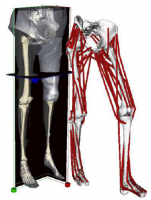One of the running VPH funded projects, NMS Physiome, recently released a new user-friendly tool package for developing OpenSim musculoskeletal models from patient-specific biomedical data.

The alpha version of the NMSBuilder application, which integrates the multimodal data fusion functionalities of the Multimod Application Framework with the OpenSim API, has been released as freeware to the biomedical community.
The software now makes it possible to build personalized musculoskeletal models from medical images with a user-friendly interface and to perform dynamic simulations of movement. Users are able to:
Information on how to download and use the application can be found here:
https://www.biomedtown.org/biomed_town/nmsphysiome/reception/alpha/
The software has been released as part of the activities of the NMS Physiome project, an international collaboration for musculoskeletal predictive medicine, that officially started on January 27th, 2010. This three-year cooperation program between two large research initiatives, the European VPHOP (The Osteoporotic Virtual Physiological Human) and the United States SIMBIOS (the NIH Center for Physics-based Simulation of Biological Structures), aims to develop synergies in terms of tools, infrastructures, and research activities related to musculoskeletal predictive medicine.
Three open-source software tools were integrated to develop the software:
Additional information:
Potential use
The NMSBuilder software has wide potentials for the biomechanical community. The application is primarily intended for biomechanics researchers with different backgrounds who use or wish to use OpenSim and deal with subject-specific scenarios at different levels in the modeling workflow of the musculoskeletal system. In addition, the software can be used as a powerful tool for editing, visualizing, fusing and managing biomedical data coming from different sources. The software is particularly suitable to simplify and speed up the data processing and model development framework using different types of subject-specific biomedical data.
Getting started
Available downloads also include a user’s manual, which describes the installation procedure and all NMSBuilder functionalities, and test data to get started with the software. Tutorials will be coming soon. Webinars and workshops are planned in the near future. Upgrades of the software and additional material will be continuously posted on the BiomedTown page: https://www.biomedtown.org/biomed_town/nmsphysiome/reception/alpha/
Upcoming development
The NMSBuilder alpha release is integrated with OpenSim 2.2.1. The software is currently being migrated to the upcoming 3.0 version of OpenSim. In addition, statistical post-processing and visualization tools will be included in the software, as well as import/export facilities for Matlab file formats.
The project: NMS Physiome
NMS Physiome is a project funded by the European Commission under the Seventh Framework Programme (FP7) to promote a more organic cooperation in the development of Predictive, Personalised and Integrative musculoskeletal medicine, as part of the European Union’s Virtual Physiological Human initiative.
The project aims to integrate communities, technologies and services developed in two large research projects: VPHOP (Osteoporotic Virtual Physiological Human) funded by the European Commission, and SIMBIOS (Center for Physics-based Simulation of Biological Structures) funded by the US National Institutes of Health.
VPHOP
VPHOP, formed by a consortium of 21 partner institutions led by Prof Marco Viceconti (University of Sheffield), is developing the next generation of health technologies to fight osteoporosis. As part of this endeavour, the personalised modelling of the patient’s neuro-musculo-skeletal system is essential.
SIMBIOS
Led by Stanford University, the project provides infrastructure, software, and training to help biomedical researchers understand biological form and function as they create novel drugs, synthetic tissues, medical devices, and surgical interventions. The cluster of projects connected to SIMBIOS is investigating a wide scale of biological structures - from molecules to organisms. Stanford University’s Scott Delp, a co-Principal Investigator of SIMBIOS, and his team focus on the accurate modelling and simulation of the neuro-musculo-skeletal system.
Useful links
Contacts: